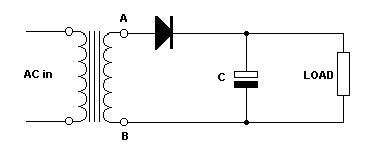 | ||
A reservoir capacitor is a capacitor that is used to smooth the pulsating DC from an AC rectifier. The reservoir capacitor releases its stored energy during the part of the AC cycle when the AC source does not supply any power, that is, when the AC source changes its phase resulting in change in 'direction of flow of current'. The change in 'direction of flow of current' of the AC source takes a very small amount of time. In this short gap of time, the continuous flow of current gradually moves to the state when it ceases. Using a reservoir capacitor, we fill this gap; since the capacitor releases its stored energy (gets discharged) in that gap of time. This allows the load to be powered at all times without any interruption.
The above diagram shows reservoir performance from a near zero impedance source, such as a mains supply. As the rectifier voltage increases, it charges the capacitor and also supplies current to the load. At the end of the quarter cycle, the capacitor is charged to its peak value Vm of the rectifier voltage. Following this, the rectifier voltage starts to decrease as it enters the next quarter cycle. This initiates the discharge of the capacitor through the load.
Performance with significant impedance source
These circuits are very frequently fed from transformers, and have significant resistance. Transformer resistance modifies the reservoir capacitor waveform, changes the peak voltage, and introduces regulation issues.
